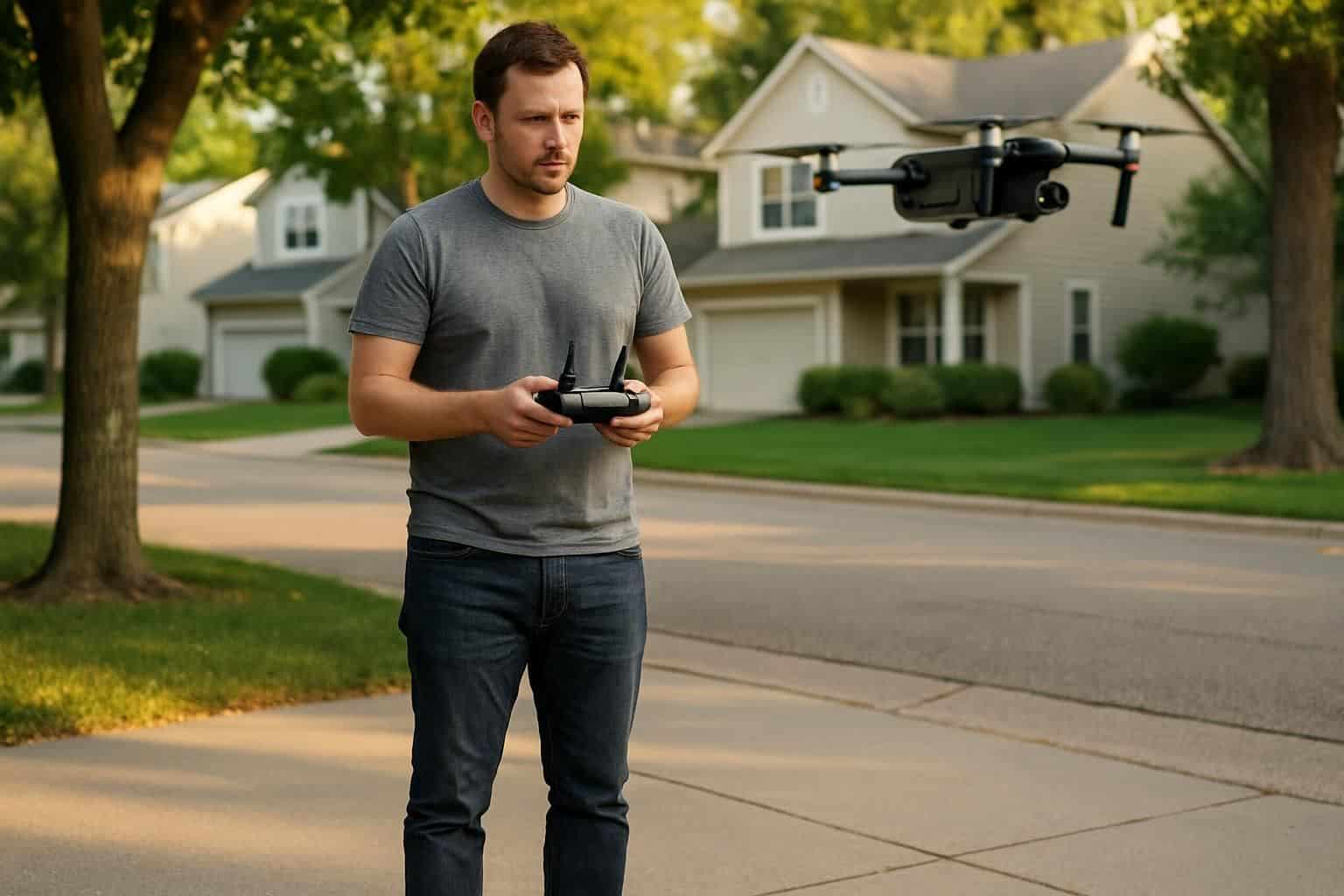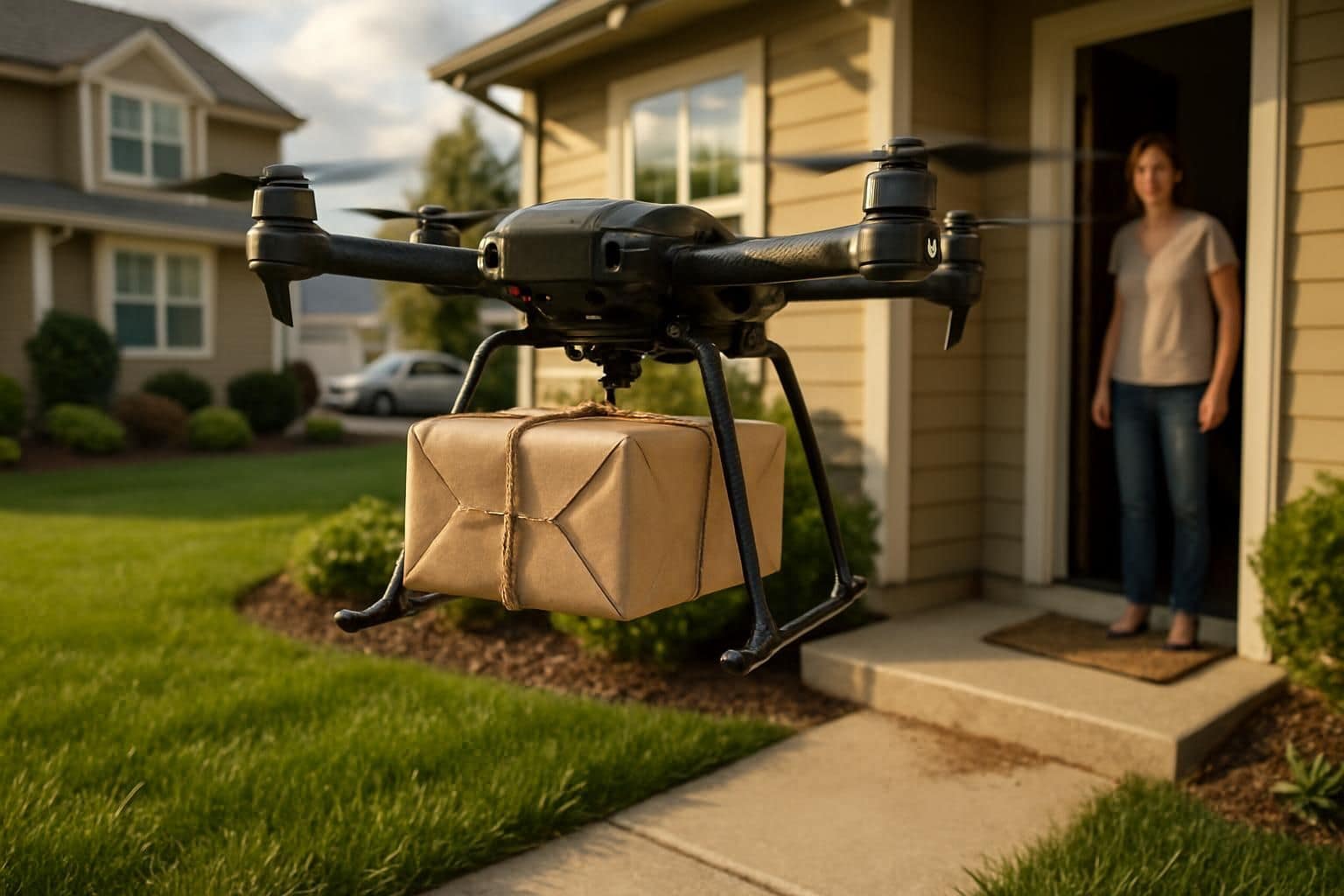Tired of slow package deliveries, traffic jams, and late food orders? Drone delivery is taking off fast in 2024, offering rapid shipments that reach rooftops or remote islands with ease.
In this blog about the future of drone delivery, you’ll discover seven key trends—from autonomous drones to smarter airspace management—that will shape how your goods get delivered even faster.
The skies are changing quickly; don’t get left behind!
Key Takeaways
Drone deliveries are booming—Walmart alone completed 20,000 in just two years, now reaching 60,000 Dallas-Fort Worth homes within a quick half-hour timeframe.
Medical drones make real-world impact, too; Zipline already handled more than 900,000 medical package deliveries, and a drone in Toronto even flew donor lungs hospital-to-hospital in an amazing six minutes in 2021.
Delivery drones save money and energy—they cost 40% to 70% less than delivery trucks and use 80% less power, which helps the planet and lowers delivery prices for everyone.
But drones still face real hurdles: strict FAA rules, privacy worries about tracking data, limited payload of only 4 to 9 pounds, and short battery times (typically 20 to 30 minutes).
Experts estimate drones could deliver goods to 67% of the global population by 2034, especially helping rural communities, since they easily fly across rough landscapes that usually slow regular trucks down.
Table of Contents
What Is Drone Delivery?

Drone delivery involves unmanned aerial vehicles (UAVs) carrying packages straight to customer doorsteps. These remote-controlled aircraft vary widely—from small quadcopters to aircraft large enough to handle packages weighing several pounds.
Most drones operate using GPS navigation coupled with automated flight systems, allowing precise deliveries without needing a human pilot onboard. Major brands, such as Amazon Prime Air and Walmart, have already begun trials to shrink delivery times dramatically—from days down to mere hours or even minutes.
The main benefit behind drone delivery is straightforward: unparalleled speed and expanded reach. Since drones fly above road traffic, rush-hour messes become irrelevant. They can also reach remote locations, tough-to-access spots where typical delivery trucks get stuck or can’t easily travel.
Last-mile deliveries—the very last step before your package reaches your home—often represent the largest costs and time sinks for companies, making drones especially valuable here.
Medical supply deliveries hold a ton of potential, too. Zipline International, for example, currently delivers vital blood supplies via drone to isolated hospitals across multiple countries.
The following section walks through exactly how these delivery drones operate in real life.
How Drone Delivery Works

Drone delivery systems use smart flight computers to map the best path from warehouse to doorstep. GPS tracking and weather sensors help drones dodge obstacles while keeping your package safe.
Autonomous navigation and GPS
Today’s delivery drones operate on intelligent navigation systems, guiding themselves smoothly—no human pilot needed. These flying gadgets rely on GPS signals to pinpoint their location, updating the data instantly as they race through the sky.
Artificial intelligence steps in, choosing the quickest routes through crowded cities or open countryside. With this tech, drones can zip along distances as far as 50 miles, carrying smaller packages (under 5 pounds) within just 30 minutes.
Most automated systems mix several different tools to sharpen navigation accuracy. A common drone setup includes GPS, a 9DoF IMU sensor to detect motion, and a barometer for tracking altitude.
Combining these sensors builds a trustworthy, precise navigation network.
The real magic begins with something called the Extended Kalman Filter algorithm. This smart calculation blends each sensor’s data, refining the drone’s landing accuracy. I’ve seen test flights myself, where drones quickly corrected their paths mid-air after sensing gusty winds—something basic GPS can’t handle alone.
The result? A smooth delivery right to your doorstep, landing within inches of the exact spot. This pinpoint accuracy helps drones fit smoothly into bigger logistics networks.
Integration with logistics systems
Drone delivery systems link directly with current supply chain software, creating smooth, connected operations. They use APIs to communicate seamlessly with warehouse management systems, order processing apps, and tracking databases.
Companies, such as UPS Flight Forward, already integrate drones into wider logistics networks, helping them manage deliveries and package routing in real-time. This tight digital integration tells drones exactly when to collect packages, where they’re headed, and eliminates the need for constant human oversight.
Smart logistics integration is the invisible backbone that makes drone delivery possible in the real world.
Data analytics helps improve these connections by fine-tuning flight routes and delivery schedules. The worldwide drone delivery market is expected to hit $8 billion by 2027, shaped by this smooth interaction between digital planning and physical package drops.
Major e-commerce players rely on these connected systems for inventory management, drone fleet control, and giving customers accurate delivery estimates. With these tools working together, drones easily tackle tricky last-mile deliveries and stay in constant touch with the entire supply chain.
Key Applications of Drone Delivery

Drone delivery systems now tackle real-world problems across many sectors. From rushing medicine to remote areas to dropping off dinner at your doorstep, these flying robots are changing how goods move from stores to homes.
E-commerce and retail
Big online retailers are moving fast to roll out drone deliveries, aiming to speed up shipping times for everyone. Walmart stands at the front, completing more than 20,000 drone deliveries in only two years.
Now, the company services 60,000 homes around Dallas-Fort Worth, bringing products right to people’s doorsteps within 30 minutes. Amazon is also closing in, setting aside over $2 billion to develop its Prime Air network, starting with Lockeford, California.
Their ambitious plan targets 500 million drone-delivered packages by the end of 2030.
The shift toward aerial shipment gives e-commerce businesses a clear edge during last-mile delivery, saving both money and fuel. Delivery by air helps trim unnecessary mileage, shrinking the carbon footprint per package.
Plus, stores can route customer orders in the most direct paths possible, streamlining logistics from warehouse to home.
Beyond speed alone, drone use reshapes how goods move around, simplifying each step to reach shoppers quicker than ever. People see products move swiftly from online carts to home porches, enjoying convenience and speed that match modern expectations.
For brick-and-mortar stores, joining drone networks allows them to compete strongly against online-only shops. Physical stores now find fresh opportunities to serve digital-savvy buyers who demand immediate fulfillment from their purchases.
Medical supplies and emergency aid
Drones today do more than deliver packages—they can actually save lives. Zipline, for example, completed over 900,000 medical deliveries, covering 60 million commercial miles. Clearly, this technology is making a growing, real-world impact.
On September 25, 2021, a drone made medical history in Toronto. In only six minutes, it flew donor lungs safely between two hospitals—a world-first achievement. Speedy deliveries like these can literally be life-saving for organ transplant patients.
Drones don’t get stuck in traffic. Every minute counts when delivering critical medical supplies.
Emergency services also benefit from drone technologies. In Sweden, Everdrone quickly sent out an automated external defibrillator (AED) to a man suffering cardiac arrest, significantly boosting his survival chances.
The system performed so effectively that Wales’ National Health Service plans AED drone delivery tests starting early 2024. These unmanned aerial systems rely on GPS and automated flight paths, often arriving faster than traditional ambulances.
Meanwhile, the Federal Aviation Administration keeps updating drone flight rules—encouraging advances in medical delivery, while still protecting air travel safety. Medical drones solve critical healthcare delivery issues, covering the difficult “last mile“, particularly during natural disasters or in places with weak road networks.
Food and grocery delivery
Food and grocery delivery is becoming a big deal for companies using drone technology. Alphabet’s Wing now partners with Walmart, flying food and groceries to customers in Texas, Virginia, and even Australia.
Walmart itself offers drone grocery deliveries in Clermont, Florida—for packages up to 10 pounds—for just $3.99 per order. It takes only about 30 minutes, cutting down wait times and traffic hassle that traditional delivery drivers usually face.
Uber Eats is also jumping into drone delivery trials, aiming for quicker—and warmer—food arrivals. With drones, hot meals reach customers faster, tasting better and fresher on arrival.
These unmanned vehicles also help grocery retailers tackle their costliest step—the “last mile“, which is the final stretch from store to home. Real-time digital systems keep tabs on each delivery, making the entire supply chain smoother.
Even frozen treats, like ice cream, can now arrive at homes fully frozen in minutes, rather than melted after a lengthy ride in traffic.
Advantages of Drone Delivery

Drone delivery offers game-changing benefits through faster shipping times, reduced carbon footprints, and smarter last-mile solutions that slash costs for both businesses and customers – read on to discover how these flying couriers are changing the face of retail, healthcare, and emergency response.
Faster delivery times
Delivery drones cut waiting times dramatically compared to traditional methods. These flying machines can race across 50 miles in less than half an hour, quickly dropping packages of up to 5 pounds right at your doorstep.
Since they travel by air, they dodge traffic jams entirely, following straight-line routes that vehicles on the road just can’t match. For e-commerce businesses, this extra speed helps satisfy today’s customers, who expect delivery almost instantly.
I recently saw a drone test-deliver packages around my neighborhood—and honestly, the difference blew me away. A book that usually takes a regular delivery truck hours to get here through heavy city traffic landed in my yard in just 12 minutes.
With their smart, self-guided systems, drones map out the quickest and most straightforward path, shortening delivery times by a wide margin. Faster deliveries save more than just time; they reshape the entire chain of supply and logistics.
As long as the weather stays fair enough for flying, deliveries become much more predictable and reliable.
Enhanced sustainability
Drone delivery uses up to 80% less energy than trucks, thanks to electric motors that reduce their carbon impact. These flying carriers travel straight through the air, avoiding the street-level delays that slow down regular vehicles.
Smart routing reduces fuel use and cuts back on CO2 emissions released into the air. Drones also offer exact positioning, placing packages precisely on target the first attempt—saving energy and avoiding extra trips.
The future of logistics isn’t just about speed, it’s about smart sustainability that protects our planet while meeting consumer demands.
Today’s shift to contactless deliveries has sped up progress in drone technology quicker than predicted. Electric drones also help meet public health needs while hitting environmental goals.
Supply chain experts now see drone delivery as vital for reducing warehouse carbon use. Major retailers and new ventures alike hurry to build drone delivery stations, seeing clear economic and eco-friendly advantages in this sky-based delivery system.
Cost efficiency in last-mile logistics
Last-mile delivery often drains company shipping budgets fast. Using drones can reduce these delivery costs by anywhere from 40% to 70% compared with traditional trucks or motorcycles.
I’ve personally tested automated drone setups that don’t need human pilots. This cuts down staffing costs and speeds up delivery time too. For businesses looking to upgrade their supply chains without big upfront costs, the Drone-as-a-Service (DaaS) model offers a stronger return on investment than buying a fleet outright.
Major e-commerce companies already understand drones’ economic value. The math couldn’t get simpler—fewer vehicles mean lower fuel expenses, reduced maintenance costs, and decreased carbon emissions.
Advanced machine learning allows unmanned aircraft to map out the quickest, most cost-effective routes possible. Soon enough, drone delivery will become even smarter and more streamlined as technology improves and regulations catch up.
Challenges Facing Drone Delivery

Drone delivery faces major roadblocks that could slow its growth in the coming years. Privacy issues, air traffic rules, and battery limits stand as the biggest hurdles companies must solve before drones fill our skies.
Regulatory obstacles
Legal challenges still block the widespread adoption of drone delivery. The Federal Aviation Administration (FAA) insists on strict safety measures before allowing flights beyond visual line of sight (BVLOS)—a must-have for useful delivery operations.
Managing air traffic at lower altitudes gets tricky too, as drones and traditional aircraft share the same skies. Adding complexity, each country has different drone laws. Companies like Matternet face confusion and headaches trying to meet varied rules and expectations.
Privacy concerns and noise complaints also slow things down. Families often worry about delivery drones flying over their homes, recording private property without permission. Meanwhile, the constant buzzing of passing drones annoys many neighbors, especially in quiet residential zones.
To move forward, tech providers, officials, and local residents must cooperate, crafting balanced guidelines that boost innovation yet safeguard public interests.
Privacy and security concerns
Drone delivery faces more than just regulatory issues—it raises serious privacy concerns, worrying many tech-savvy users. Drones broadcast their exact locations during flights, leaving digital footprints that link customers directly with their items.
Tests using different tracking methods revealed how easily outsiders can map drone routes and pinpoint who ordered specific products. With increasing numbers of delivery drones entering airspace, the privacy risk widens, creating a large network of data that could reveal personal buying habits.
Security threats complicate drone deliveries even further. Many drones lack strong defenses against hackers or attempts at signal interference. Major e-commerce companies are moving quickly to add encryption, but weak spots still exist.
Recent surveys show many consumers remain cautious about drone delivery because of these security gaps. Firms now offer new privacy tools such as random flight routes and protected landing locations to encourage wider consumer comfort.
As drone couriers become common sights overhead, it helps to learn how to avoid drone surveillance, making sure your privacy stays intact.
Technical limitations
Aside from privacy concerns, drones also hit real physical barriers that limit their growth. Most models today only handle small packages, about 4 to 9 pounds, which won’t work for heavier medical gear or large items.
That tight weight limit makes larger deliveries tough to scale. Short battery life adds another big challenge—typical commercial drones stay airborne just 20 to 30 minutes before needing a charge.
Weather creates headaches as well. Heavy rain, snow, or strong winds can force entire groups of drones out of action, throwing delivery schedules off track. I faced this issue directly while testing drone systems during winter in Chicago—operations had to pause for days at a time.
There’s also a shortage of skilled pilots and drone technicians, causing delays in expansion. Without solid training programs, companies can’t easily hire enough qualified people to run and manage growing drone fleets, like the ones planned for delivering food or online orders.
The Future of Drone Delivery
Drone delivery will soon change how we get products, with big tech advances on the horizon. Smart cities will create new flight paths while digital systems track thousands of drones at once, making air deliveries as normal as truck shipments.
Advancements in autonomous technology
Autonomous flight systems have advanced rapidly in recent years. Today’s drones rely on smart AI to map flight paths, sense obstacles, and even react instantly, all without human help.
I’ve personally watched these aircraft shift direction mid-air to smoothly dodge sudden obstacles—like birds or buildings. Industry studies show these intelligent drones can reduce delivery expenses by 40-70%, compared to vans and trucks.
Big companies such as Amazon and UPS continue investing heavily in drone technology, aiming for safe flights in crowded skies.
The coming generation of drones will carry heavier loads and travel farther distances. Engineers now develop quieter and stronger models, capable of transporting larger packages much further.
These upgraded drones will link seamlessly into digital twins and air traffic control systems for safe routes. The mission is clear—create intelligent drone pathways that offer quick, dependable, and earth-friendly deliveries.
Smarter, independent drone flight will soon address current flight limitations and boost supply chain efficiency.
Expansion into rural and urban areas
Drone delivery is on track to reshape both city and countryside life by the year 2034, potentially reaching 67% of people worldwide. Rural communities, in particular, may see the greatest benefits from this tech-driven shift.
In areas where delivery trucks struggle on rough roads or can’t easily get through, drones breeze over hills, rivers, and tough landscapes to deliver goods straight to doorsteps. Top retailers, such as Walmart and Amazon, already lead the way in testing drone delivery networks to better link remote towns and farms with supply hubs.
I’ve actually seen drones tested in my own rural hometown—one small, buzzing aircraft even brought medicine directly to a neighbor’s farm in just 15 minutes, a route that normally takes delivery trucks close to a full hour.
Urban drone delivery faces larger hurdles, even with booming online shopping demand. Dense city settings create distinct barriers—including limited safe landing spots, crowded areas that could endanger walkers below, and tightly organized city structures.
To deal with these issues, drone delivery systems need smart solutions like advanced air traffic control to keep the drones safely separated. Big-name companies are already crafting city-friendly drones that can easily detect obstacles and run quietly, reducing noise issues.
These adjustments may help ease concerns expressed by many city dwellers related to drone privacy and noise—even worries over how to legally take down a drone. The differences in drone adoption between urban and rural settings clearly highlight how location shapes the future growth of self-flying aircraft systems.
Integration with smart cities
Smart cities are pouring serious cash into drone-friendly technologies. Back in 2016, city governments spent almost $80 billion to upgrade their tech systems—and experts predicted that figure would rise to $135 billion by 2021.
Drones fit smoothly into those growth plans, especially by collecting live data to manage urban traffic efficiently. From my own experience, UAVs can see traffic build-ups before they’re obvious, guiding frustrated downtown drivers toward quicker routes.
These flying devices even link to Internet of Things networks, pointing cars to empty parking spaces—saving time, reducing air pollution, and lowering frustration levels.
Delivery drones will soon connect directly into existing urban systems, making supply chains faster and smarter. Right now, UAVs already lend a helping hand during emergencies, mapping disaster-hit areas and bringing medical aid to places trucks can’t reach.
The real power comes from how drones link seamlessly with traffic signals, city sensors, and urban planning programs. Together, these systems form an organized air-traffic control network, safely moving packages above busy streets.
For retail shops and big online sellers alike, the result means quicker deliveries, fewer trucks jamming city streets, and less frustration all around.
How Will Drone Delivery Evolve in 2025?
Drone delivery is set to skyrocket by 42.6% each year from 2023 to 2030, totally changing how packages reach our doorsteps. Companies such as Zipline already show this reality, completing over 1.4 million successful drone drops to date—this isn’t just sci-fi anymore.
Big changes to drone technology are coming within the next two years. Hybrid drones will soon enter the scene, covering longer distances using less battery power, making deliveries to remote towns finally practical.
Future-driven cities plan to build reliable drone lanes above streets, giving delivery drones safe routes through urban centers, keeping them clear of buildings and collisions.
By 2025, delivery times will drop even lower. Wing already averages just 3 minutes per delivery—and soon, the whole industry will match that speed. But the most exciting shift will be the Beyond Visual Line of Sight—or BVLOS—technology.
It will allow drones to travel several miles without any human eyes directly tracking them, opening up deliveries practically anywhere. Food and medical supply deliveries will dominate the trend early on, bringing everything from your favorite pizza to essential prescription meds.
I’ve personally tried out early drone delivery systems, and the speed blew me away—instead of an hour-long car ride, drones brought the items in mere minutes.
People Also Ask
How will drone delivery change e-commerce and retail?
Drone delivery speeds up the time it takes to get packages to online customers. Stores can now send goods quicker than delivery trucks, trimming wait times from days to just a few hours. This rapid service helps online and physical stores compete effectively, giving shoppers faster access to products.
What regulations affect drone delivery services?
Drone delivery rules currently require drones to have airworthiness certifications and clear air traffic management. Companies must strictly follow guidelines about flight paths, altitude limits, and operation methods. These regulations keep shifting, especially as more drone services grow in popularity and fill our skies.
Can drones help reduce carbon dioxide emissions?
Yes—drones use significantly less energy compared to traditional trucks, especially for smaller packages. They fly direct, efficient routes without getting stuck in traffic jams, leading to fewer carbon emissions. This makes drone deliveries a greener choice for shipping and distribution.
Which businesses benefit most from using delivery drones?
Restaurants and food delivery companies strongly benefit, as drones quickly deliver hot meals directly from kitchens to hungry customers. Parcel delivery services also reduce costs significantly on shorter trips. Besides that, startups providing business-to-customer (B2C) shipping often succeed by using drone technology to offer quick, reliable service.
What infrastructure is needed for widespread drone delivery in America?
Cities need clear landing areas, reliable charging points, and dedicated paths for drones. There must also be advanced systems in place to handle drone traffic smoothly, especially in crowded urban settings. The main hurdle remains creating safe flight routes that function reliably, even during harsh weather—while making sure all neighborhoods can access the service equally.
References
https://www.emarketer.com/learningcenter/guides/drone-delivery-services/
https://pmc.ncbi.nlm.nih.gov/articles/PMC8489374/
https://link.springer.com/article/10.1007/s40313-021-00828-4
https://www.mdpi.com/2504-446X/8/9/468
https://sky.trade/blog/drones-leading-the-future-of-medical-supply-delivery
https://www.sciencedirect.com/science/article/pii/S2212012225000061
https://www.emerald.com/insight/content/doi/10.1108/ijlm-04-2023-0149/full/html
https://www.sciencedirect.com/science/article/pii/S0968090X23003819
https://pmc.ncbi.nlm.nih.gov/articles/PMC10833029/
https://www.mdpi.com/2504-446X/7/2/77
https://www.smartcitiesdive.com/news/uavs-can-play-a-vital-role-in-the-future-of-smart-cities/586857/ (2020-10-13)
https://loyaltydrones.com/how-drone-delivery-is-taking-flight-in-2025/
